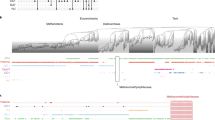Abstract.
Cellular systems to control an appropriate DNA geometry for function probably evolved simultaneously with DNA genomes. Such systems are basically DNA topoisomerases and DNA-binding proteins. Therefore, their distribution in extant organisms may be a source of information on early evolution and the nature of the last common ancestor (cenancestor). Most living beings need the strand-opening potential of negative DNA supercoiling to allow transcription and other DNA-dependent processes. Mesophiles have global negatively supercoiled DNA, essentially due to gyrase (introducing negative supercoils) in bacteria and to DNA wrapping around histone cores in eukaryotes. Mesophilic archaea, halophilic methanogens, and halophiles might use a gyrase, whereas some methanogens might use histone wrapping. The existence of these two distinct mechanisms suggests that mesophily appeared at least twice in evolution. On the other hand, only one system which is based on reverse gyrase (introducing positive supercoils) appears to be required for hyperthermophilic life. Archaeal hyperthermophiles lacking gyrase have relaxed to positively supercoiled DNA, but hyperthermophilic bacteria of the genus Thermotoga, which have both gyrase and reverse gyrase, have negative supercoiling. This suggests that reverse gyrase is necessary at least locally, but whereas these hyperthermophilic bacteria favor general melting potential and stability at critical active regions, hyperthermophilic archaea favor general linking excess and local melting. In this context, the existence of a thermophilic (60–80°C) ancestor endowed with only relaxing topoisomerases is hypothesized. Such temperatures allow a compromise between melting potential and stability, i.e., an appropriate DNA geometry for function. Subsequent duplication and functional specialization of existing DNA topoisomerases would then have facilitated adaptation to hyperthermophily and mesophily in archaea and bacteria, respectively. If reverse gyrase is an ancient character in hyperthermophilic bacteria, the cenancestor would have already been a hyperthermophile. Histone sequence homology and similarities of nucleosome structural dynamics suggest that eukaryotes inherited this system for DNA structural homeostasis from methanogenic euryarchaea. Some mesophilic archaea would have improved their adaptability to mesophily by importing gyrase from bacteria.
Similar content being viewed by others
Author information
Authors and Affiliations
Rights and permissions
About this article
Cite this article
López-García, P. DNA Supercoiling and Temperature Adaptation: A Clue to Early Diversification of Life?. J Mol Evol 49, 439–452 (1999). https://doi.org/10.1007/PL00006567
Issue Date:
DOI: https://doi.org/10.1007/PL00006567




